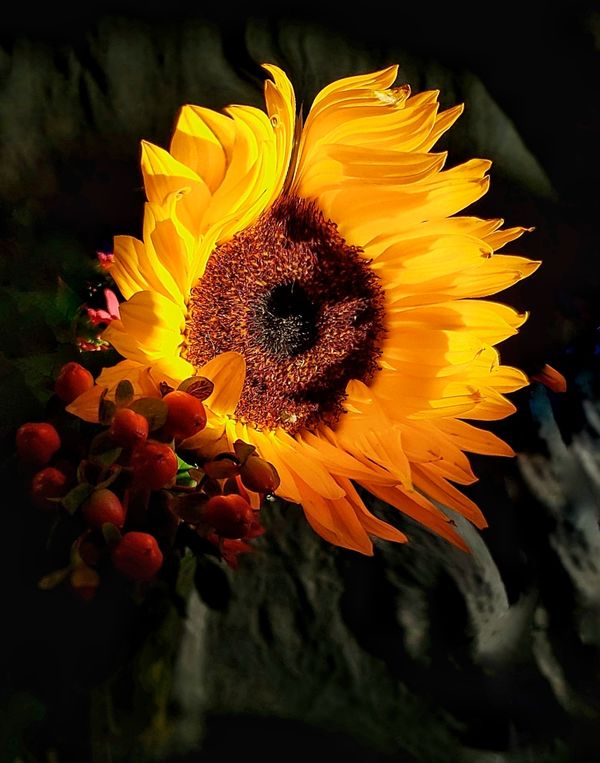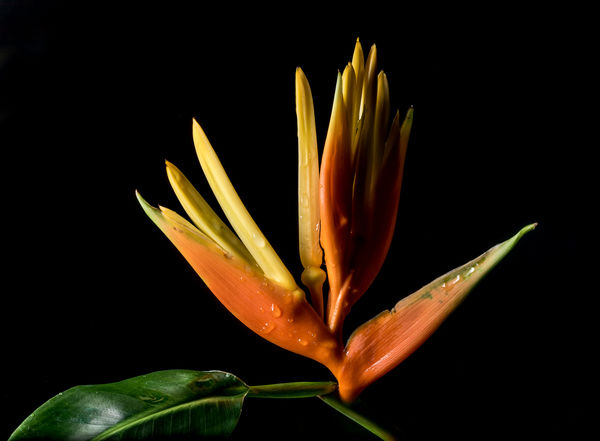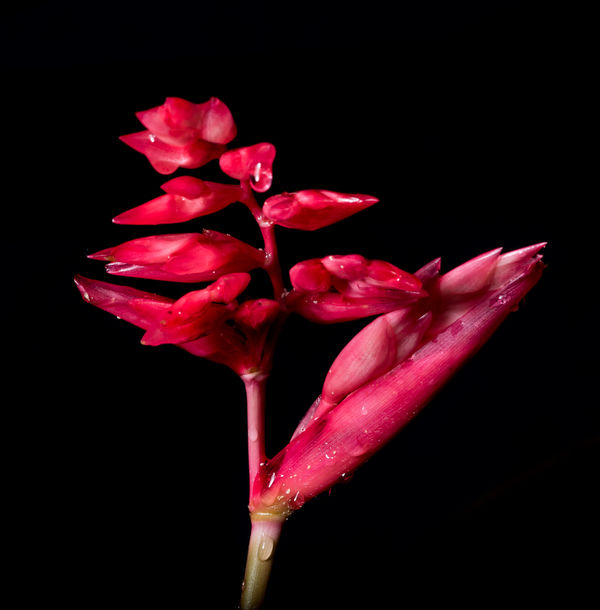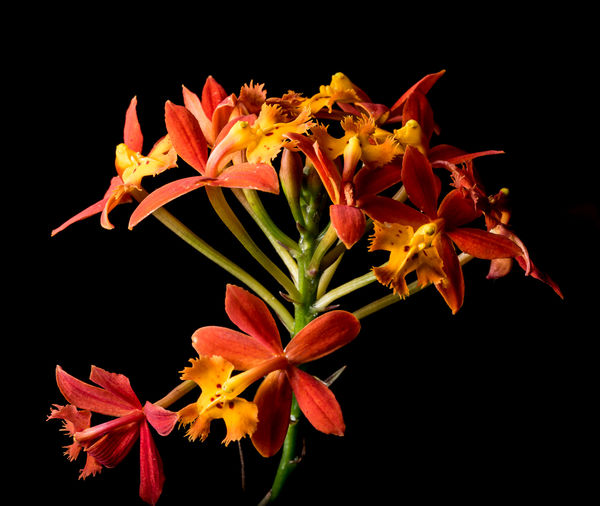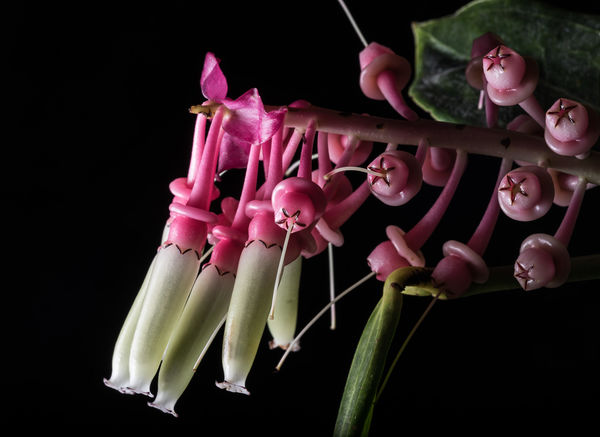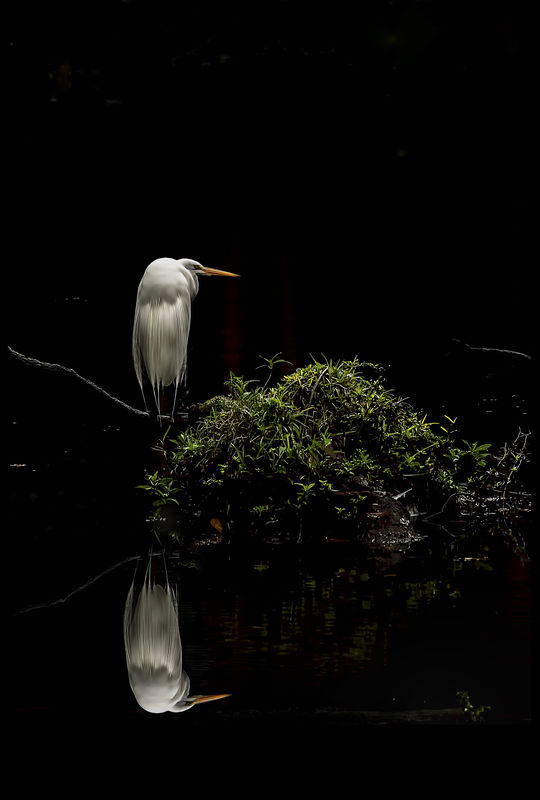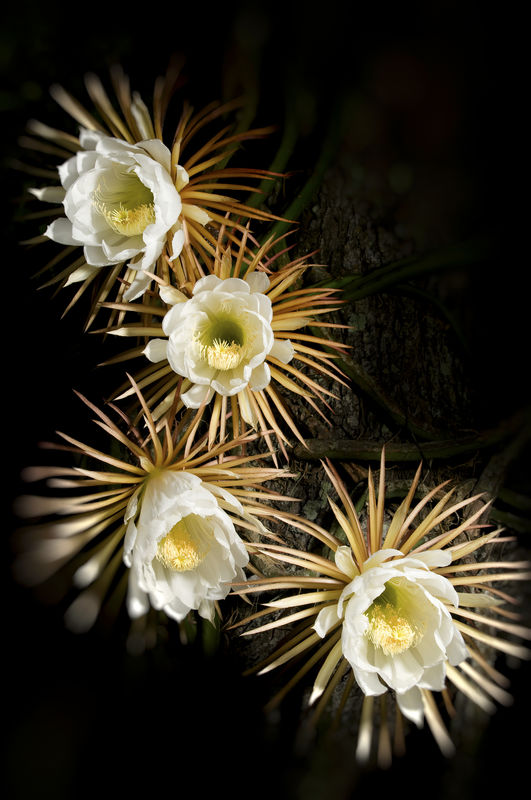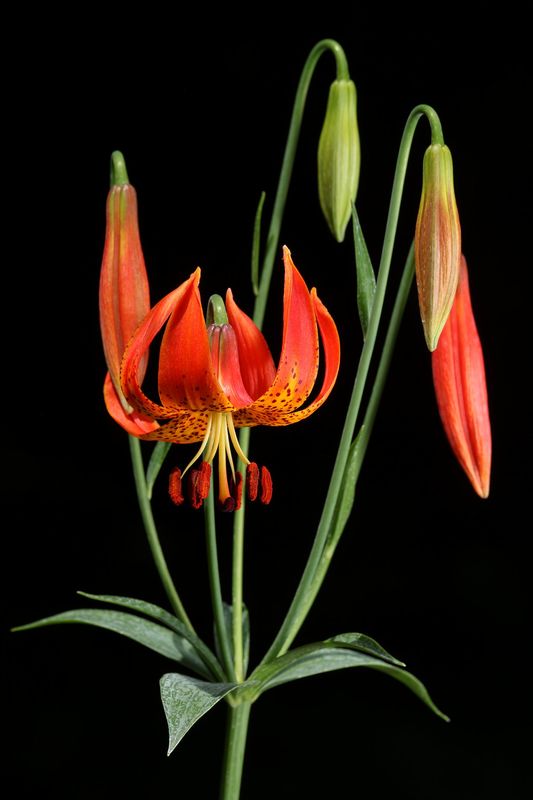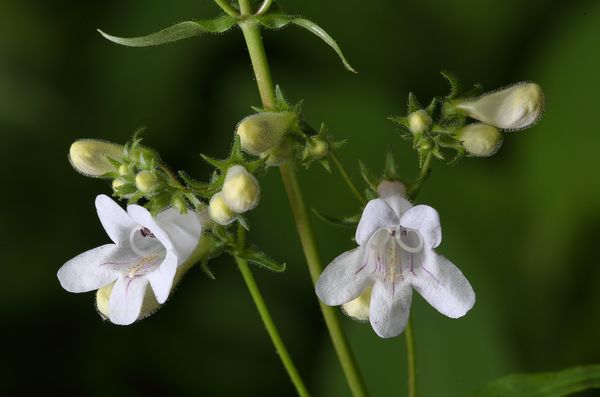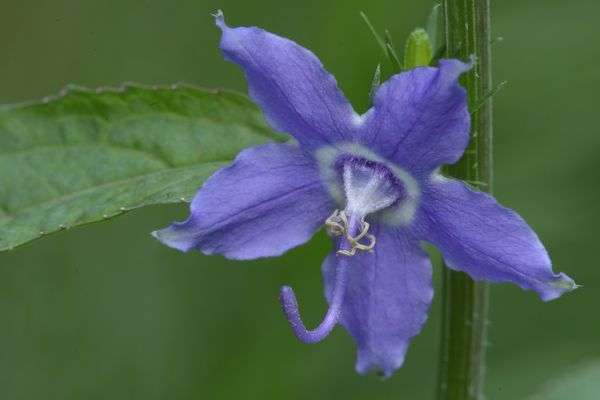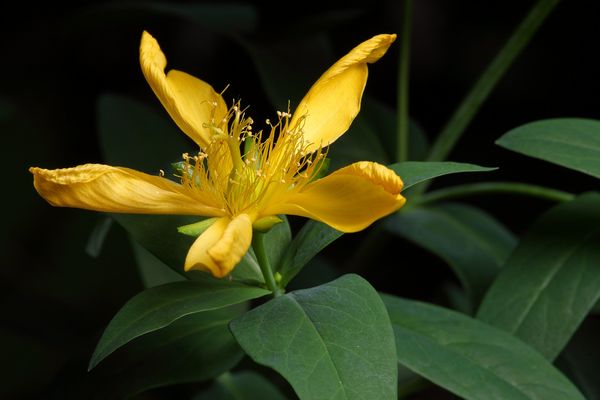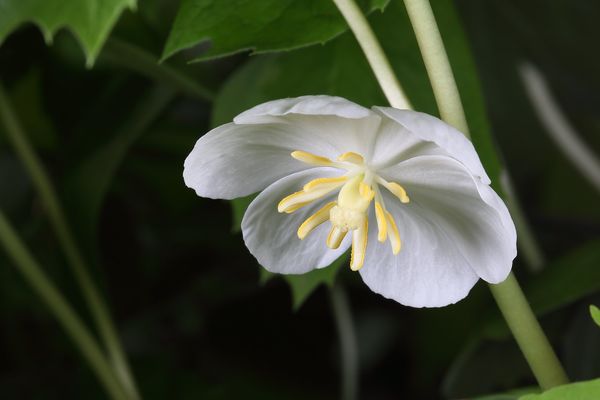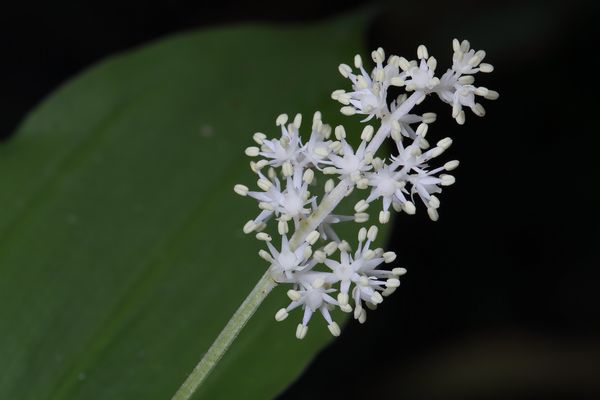i think i know how it's done
Oct 19, 2018 10:21:24 #
As Linda illustrated, whe, the lighting is directional, especially back lighting you can expose for the highlights and let the background go dark.
Another method is subtractive lighting. When I work out of doors on small subjects, I carry one of those collapsible reflector/gobo things- silver on one side and black on the other. The cloth is mounted on a spring-loaded hoop. I can either use it as a gobo and shade the background. If you want a jet black background, you can employ the black side as a background- good for cluttered or overly lighted background areas. Or you can use the silver side to pump in some redirected sunlight to create highlights on flowers that are in shaded areas. You can do a similar treatment with off camera flash and adjust the shutter to underexpose the ambient light but when using gobis and reflectors, you can more easily see and predetermine the exact effect right in the viewfinder.
Backlighting, either natural or redirected, is especially nice when it transilluminates the petals or leaves.
Personally, I like to see a little color or tonal mass in the background rather than jet black- it creates more depth and dimension and the illusion that the viewer can enter the image and walk around the subject. If however, you want the blackest black effect- use a black velvet cloth behind the flower- that material just eats light!
Another method is subtractive lighting. When I work out of doors on small subjects, I carry one of those collapsible reflector/gobo things- silver on one side and black on the other. The cloth is mounted on a spring-loaded hoop. I can either use it as a gobo and shade the background. If you want a jet black background, you can employ the black side as a background- good for cluttered or overly lighted background areas. Or you can use the silver side to pump in some redirected sunlight to create highlights on flowers that are in shaded areas. You can do a similar treatment with off camera flash and adjust the shutter to underexpose the ambient light but when using gobis and reflectors, you can more easily see and predetermine the exact effect right in the viewfinder.
Backlighting, either natural or redirected, is especially nice when it transilluminates the petals or leaves.
Personally, I like to see a little color or tonal mass in the background rather than jet black- it creates more depth and dimension and the illusion that the viewer can enter the image and walk around the subject. If however, you want the blackest black effect- use a black velvet cloth behind the flower- that material just eats light!
Oct 19, 2018 10:25:04 #
Oct 19, 2018 10:26:27 #
Oct 19, 2018 10:33:28 #
E.L.. Shapiro wrote:
This is stunning, Ed! I like your suggestion about including a bit of detail/texture behind.Sun flower.
Papa Joe wrote:
Appreciated!Excellent technique and results, Linda!
God Bless,
Joe
God Bless,
Joe
Oct 19, 2018 10:51:58 #
uppics wrote:
almost everyday, i see shots of flowers w/ black backgrounds; is this accomplished @ night or is a flash (either on camera or off camera) used during the day to make such a shot? thanks for answering.
There are several ways to do this. One is to use a black velvet background - it will reflect very little light, but may not always be practical.
Another is to use post processing to mask out the background, and replace it with solid black.
The way I tend to use most often, is to use wireless trigger, a hand held flash with a large-ish reflector/bounce card (9x12), and move the flash next to the flower (or other subject). Keeping the flash and bounce angled in such a way that the edge of the bounce prevents light from reaching objects in the background, in effect, "flagging" the light. I have the output turned way down - but the proximity allows for an Fstop of F22, and using a shutter speed of 1/250 will ensure little, if any ambient light. It also provides a very short flash duration - about 1/20,000 sec - so no opportunity for motion blur. The proximity of the flash to subject - usually about 8-12 inches, causes the light to decay dramatically, providing some interesting play between light and shadow.
If you had orangutan arms (or an assistant) you could do some interesting backlighting effects.
Oct 19, 2018 10:58:12 #
uppics wrote:
almost everyday, i see shots of flowers w/ black backgrounds; is this accomplished @ night or is a flash (either on camera or off camera) used during the day to make such a shot? thanks for answering.
Let me start with saying the techniques already mentioned work quite well , on the other hand not in all situations the bird for example was shot with a nikon d7100 I could not go out and put a black piece of mat board behind him and could not wait till dark .This image was shot at mid day although he was in soft shadow I exsposed with spot metering the smallest spot I could use on the brightest area of the bird , this under exposed the background ,no ettr here known as expose to the right ,I do not subscribe to that technigue . I expose based on what I want to exspess to you . If you look close you will see a tadpole in his beak that was not a by chance moment , this is one shot in single shot mode waiting for the right image ..the flowers were shot at night , because they are night blooming Cereus but not flash to harsh , but with a pen light about 5 seconds each on a 30 sec exposure....niether needed but a little post production because I also shoot raw . I use CS6 but it could easily be done in the raw opperator that comes with your Camera . I understand these are unique situations but it reading and knoledge of what your camera is capable of .I come from a time when my instructor did everything he could in camera in in the film era , so he didnt have to do it in the darkroom . Our cameras are amazing today , I now own a nikon d810 , the d750 , and the new d850 have feature in common with my camera called highlight wieghted metering no more blown skies , I use it in daylight although designed for stage events , it has the ability to stop overexposure of highlights in an image , with the camera set at ISO 64 my dynamic range is at its highest and recovery of shadows is emence this is a direction our cameras are going thanks for reading , you need to take in all of the sugestions these people posted and use them all thoughout your time using your camera good luck..P.S the flowers were shot with a nikon d300 12.3 megapixels.
Oct 19, 2018 12:19:42 #



--Bob
Linda From Maine wrote:
The drawback to using an on-camera flash IMO is you are lighting the subject from the front. Often, side or back light brings out textures and emphasizes shapes that aren't possible with direct light. It really just depends on personal taste and what you're trying to achieve - dramatic contrasts of light and dark such as the two I posted, or more evenly distributed lighting. Well worth study and experimentation!
Oct 19, 2018 13:11:44 #
uppics wrote:
almost everyday, i see shots of flowers w/ black backgrounds; is this accomplished @ night or is a flash (either on camera or off camera) used during the day to make such a shot? thanks for answering.
There are many ways... Carry black Velcro rolled up in a corner of a back pack. Or mount it on a set of folding foam core boards. Or use off camera flash to get the main exposure five or more f/stops brighter than the background. Or use a blocking flag on the background and a reflector on the subject.
Norman, Westcott, and other lighting supply companies sell pop-up 4-in-1 or 5-in-1 reflectors (I like the 5-in-1 with white, black, gold, and silver reflectors that fit on a core of diffusion material and pack down to about an 18-inch pouch). A few of those, with light stands and reflector clamps, are mighty handy for all sorts of work!
Oct 19, 2018 13:14:38 #
Oct 19, 2018 13:15:45 #
Oct 19, 2018 13:19:38 #
i have never used flash is there a way to not make these look so flat and one dimensional?
interested in trying flash
thanks
interested in trying flash
thanks
Oct 19, 2018 15:51:05 #
Redron wrote:
i have never used flash is there a way to not make these look so flat and one dimensional?
interested in trying flash
thanks
interested in trying flash
thanks
Flash must be used off camera to preclude flat on-camera flash lighting. It can be the main ligh source whereby the ambient light is controlled by the shutter speed. If the available light is yourot primary source, the flash can be used as a fill light- it can be on camera but must be two or more stops below the ambient light.
Oct 19, 2018 16:31:25 #
uppics wrote:
almost everyday, i see shots of flowers w/ black backgrounds; is this accomplished @ night or is a flash (either on camera or off camera) used during the day to make such a shot? thanks for answering.
I can consistently get black or near black backgrounds behind flowers with off-camera diffused flash, if I want to do that. However, that can become stark and boring sometimes, so I would much rather get a little color in the background. At the same time, I try to limit distractions on the background. That can mean using a diffuser to soften direct sunlight and the hotpots and harsh shadows that causes, and carefully choosing the subject and the angle for the shot. The goal is to get separation between the subject and the background.
The first image was on an overcast day, using two off-camera diffused flashes very close to the subject. There was nothing within 10 feet or so behind the subject, so at f/16 and 1/200th of a second the background went black.
Mike
Oct 19, 2018 16:34:18 #
Here are a couple of shots that get good separation between the subject and the background, but that have a little more interesting backgrounds without the backgrounds being a distraction.
Mike
Mike
Oct 19, 2018 16:37:43 #
There are something of a hybrid between the two approaches.
Mike
Mike
If you want to reply, then register here. Registration is free and your account is created instantly, so you can post right away.

